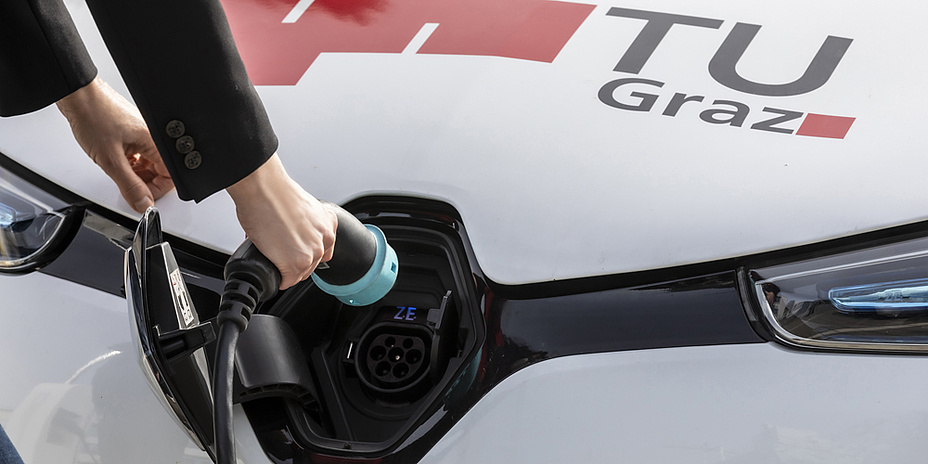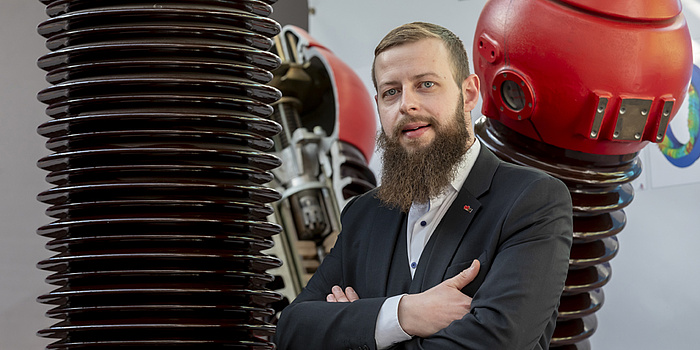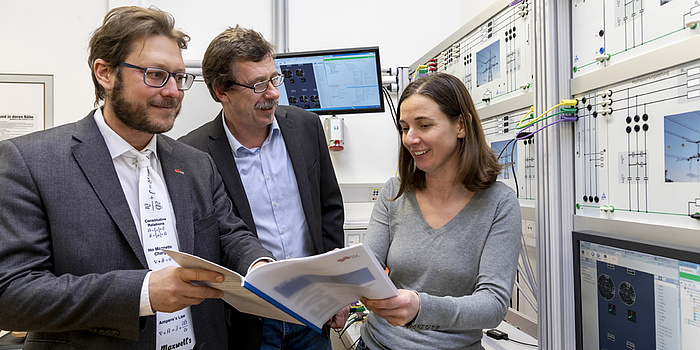Fitness check: Energy Transition, Electricity Grids and Electromobility

News+Stories: You both deal with electricity grids, their safety and expansion. Are our electricity grids ready for the increasing demand for electricity, in particular due to electromobility?
Herwig Renner: If, in the future, we want to charge our vehicles very quickly, we will need very high power. With our current low-voltage and medium-voltage grids, this will probably not be feasible. If only because, in addition to electromobility, there is also a great demand for heat pumps and the desire to have one's own photovoltaic systems. Of course, it could be said that what photovoltaics additionally feed into the grid is taken back by heat pumps and electric vehicles, so there is a balance. But it's not really like that, because it doesn't happen at the same time or in the same place.
Daniel Herbst: Different figures are circulating. On the one hand, there is talk of 1.6 million electric vehicles by 2030, on the other of 1,500 charging points with 150 kilowatts of charging power each for e-cars and 1,300 charging points for e-trucks with 1 megawatt each at transport hubs throughout Austria. If these figures are correct, then we are not talking about a few additional transformers, but rather entire substations that would have to be rebuilt to provide these services.
Renner: Of course, we don't just have to look at the fast charging stations at transport hubs, but also at the charging stations or wall boxes at individual households where users want to charge their vehicles at home. If this is one person in a settlement, then it has hardly any effect on the distribution network. But if there are 100 households at the same time, the additional load can exceed a critical threshold. Here, the major challenges lie primarily in the regulation and grid-serving behaviour of individual households.

What do you mean by that?
Renner: If I plug in a vehicle in the evening and need it again in the morning to drive to work, it doesn't necessarily have to be charged immediately. Here, for example, an artificial intelligence could autonomously ensure that the car is charged when the load on the grid is low or when there is a lot of electricity available.
Herbst: The same applies to other household appliances such as washing machines or dishwashers. As a user, I then only express the wish that my vehicle is charged by 7 am and my laundry is washed by 6 pm. And the system takes care of the rest by itself.
Is that all it takes? Does this prepare us for the challenges of the energy transition?
Renner: No. It is certainly worthwhile to find ways to use our existing network infrastructure more efficiently. It is currently designed for rarely achieved peak performance. But we will not get around a faster grid expansion.

What is necessary or desirable for this from a research perspective?
Renner: This is very difficult to quantify. In particular, we need to expand in the area of medium and low voltage. Or consider whether a technological switch to direct current grids would not make sense in certain cases. This would allow higher power to be transported over longer distances to a large extent underground. But this network would also have to be built from scratch.
Herbst: With regard to electromobility, there is also the possibility of storage-integrated charging infrastructure. These are charging stations in exposed locations that are not used on a continuous basis and could therefore use storage that is charged slowly over several days. Or battery exchange systems. One battery is slowly charged while the other is in use.
Renner: The big challenge currently lies with the network operators. In order for me to slowly charge a vehicle at home, I only need to make a few changes to my own home installation. But if too many people in my immediate vicinity do this, then it becomes a problem at the low-voltage transformer at the latest. Grid operators must counteract this with expansion and control engineering.
The networks are constantly being expanded and extended. But can expansion keep up with the contemporary changes in society?
Renner: At the moment, society is changing faster than the expansion of our networks. If we want to achieve the 2030 climate targets, this is far too slow. At the moment, delivery times for infrastructure are also enormous and there is a lack of qualified personnel.
Grid expansion also means more lines, doesn't it?
Renner: We are talking about the distribution network here, and that takes place predominantly underground. But it's not just the lines. There is also opposition to new photovoltaic plants in grassland and to wind turbines on mountains. Which I also understand.
Why are such new facilities not built on existing infrastructure such as car parks, roofs or roads?
Renner: More and more is happening. Several companies already offer stands for photovoltaic panels that can be placed on car parks or integrated into façades. Last but not least, such installations can be used for additional shading. With existing infrastructure, however, it’s always a question of statics – and of course costs. The cheapest and quickest way to obtain as many square metres of photovoltaic space as possible is still to build on grassland.
What are you currently working on?
Herbst: Together with research and corporate partners, I am primarily working on the topic of vehicle-to-grid – in other words, the possibility of storing sustainable electricity temporarily in electric vehicles. On the other hand, I also deal with the safe operation of charging infrastructure. Public charging stations are very often exposed and must withstand mechanical influences as well as the weather. And I’m also active in electrotechnical standardisation in the Austrian Association for Electrical Engineering. Electromobility is a multidisciplinary topic, from the generation of electrical energy, distribution, installations and transfer to the charging infrastructure to the charging of the vehicle. Many sectors are working together to meet the challenges.
This article is part of the current TU Graz dossier "Recharched" on the topic of electromobility. At www.tugraz.at/go/dossiers you will regularly find news, interviews, basic information, contacts to experts, videos, podcasts and expert opinions on a new focus topic.
Kontakt
Herwig RENNER, Ao.Univ.-Prof. Dipl.-Ing. Dr.techn.
Daniel HERBST, Dipl.-Ing. BSc
Institute of Electrical Power Systems
Inffeldgasse 18/1
8010 graz
Phone: +43 316 873 7551




